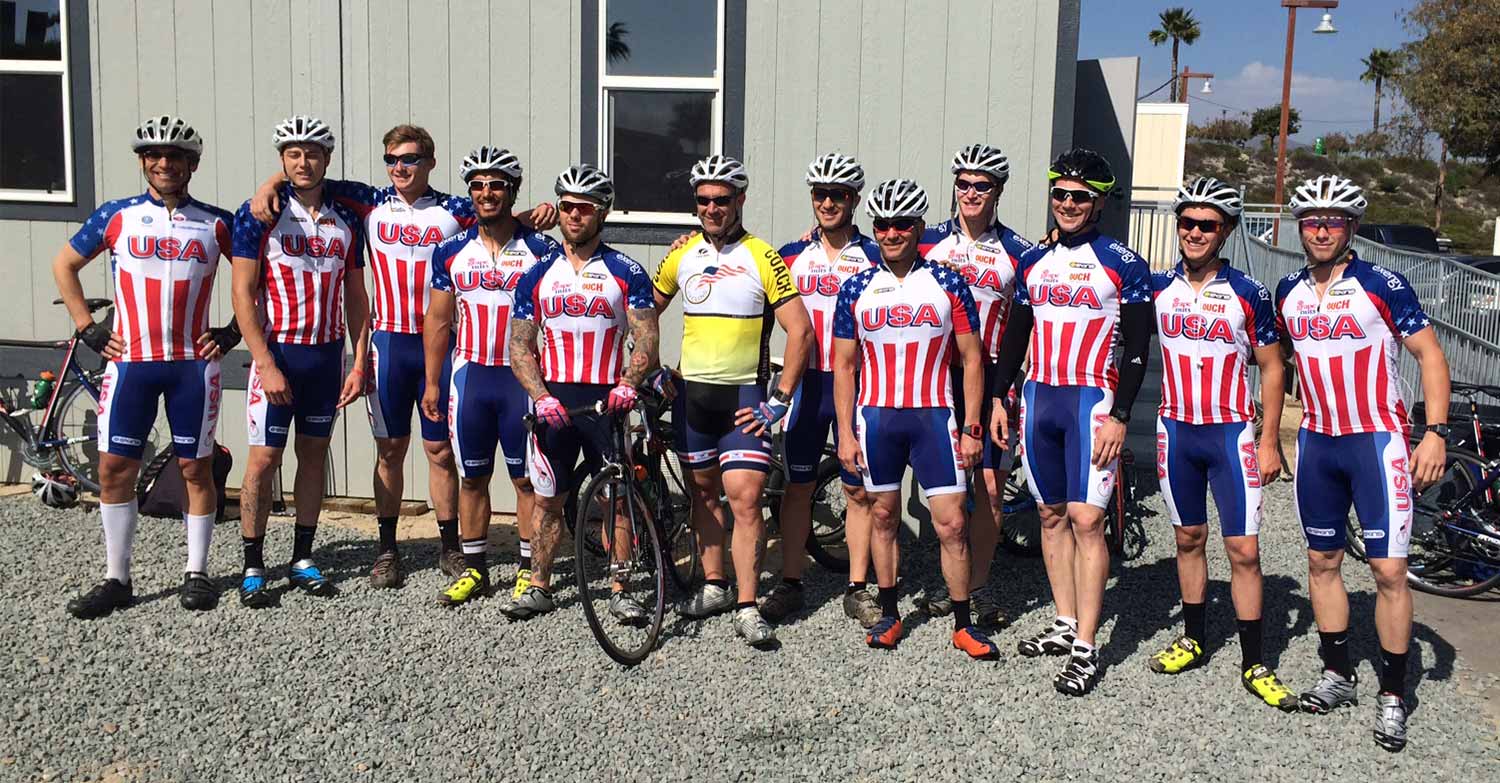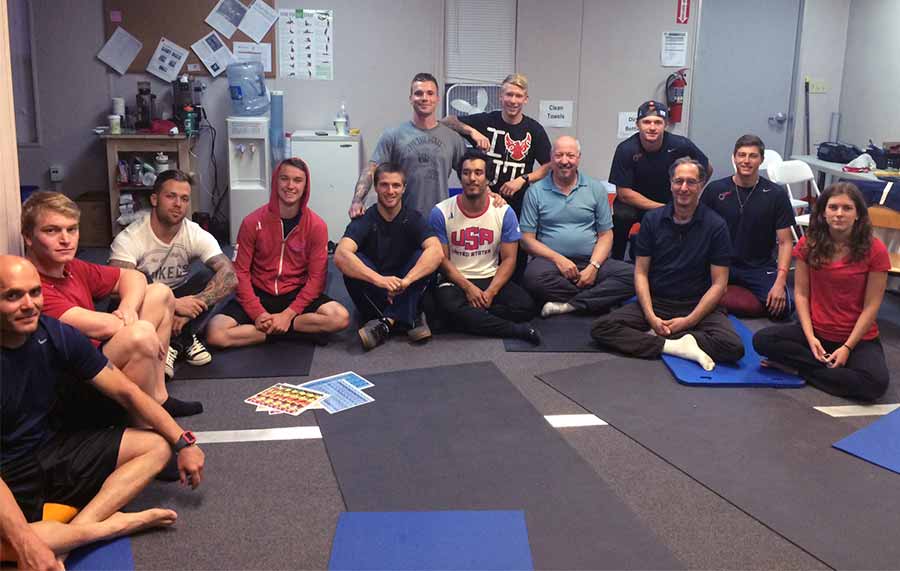By:
- Christina Johnson
Published Date
By:
- Christina Johnson
Share This:

Team photo with Martin Paulus on far left. Photos by Steven Hickman, UC San Diego
Mindfulness Training Program May Help Olympic Athletes Reach Peak Performance
Research suggests that meditation may help U.S. military personnel cope with the stresses of combat more effectively. Now, UC San Diego researchers are looking at whether strengthening the mental muscle of Olympic athletes could confer a competitive edge in the world of sports, too.
The early results, though not definitive, are promising: The first group of athletes to complete a mindfulness training program developed at UC San Diego won first, second and third place at the 2014 USA Cycling Elite BMX National Championships.

“Selfie” of Barry Nobles, Connor Fields and Steven Cisar. Photo by Barry Nobles.
Though the podium sweep is not being directly attributed to the mind-focusing benefits of meditation, the athletes, their coach and the health care practitioners who developed the mindfulness training program acknowledge the value of addressing psychological dimensions of winning races.
"You hear athletes say, 'My head wasn't in it,' " said Lori Haase, a postdoctoral fellow at the UC San Diego School of Medicine who developed the mPEAK training program with Steven Hickman, director of UC San Diego Center for Mindfulness, at the request of the USA BMX team coach. "Most of the time, people in sports have focused on the neck down. They focus on nutrition, on building muscle or eye-hand coordination, but they ignore what is going on in the head. Scientists are really beginning to be able to see that thoughts can get in the way of performance."
James Herrera, coach of the USA BMX team, approached UC San Diego researchers after reading an article entitled “Cracking the Athlete’s Brain” in Outside magazine that featured research on peak performance and mindfulness training by Dr. Martin Paulus, a UC San Diego professor of psychiatry and Haase’s academic mentor.
Herrera, whose team is based at the U.S. Olympic Training Center in Chula Vista, said he recognized that the type of mental exercises that the Paulus’ lab was studying might be able to help his team stay clutch. The USA BMX team won three medals in the 2008 Olympics, the first Olympics featuring the sport, but took no medals at the 2012 London Games. "It was clearly a psychological thing," Herrera said.
The mindful Performance Enhancement, Awareness and Knowledge (mPEAK) program is an intensive course on meditation and body awareness. It also teaches athletes how to better deal with pain, stress and failure and how to cultivate a positive mental attitude. For example, perfectionism is considered to be an impediment to reaching one’s full potential.

From left, James Herrera, Connor Fields, Barry Nobles, Sean Gaian, Nick Kohler, Steven Cisar, Jared Garcia, Thomas Zula, Steven Hickman, Tanner Sebesta, Allan Goldstein, Jordan Miranda and Lori Haase.
After completing the program, the cyclists were directed to practice mindfulness training 20 minutes, twice a day, and to attend weekly 90-minute follow-up sessions with instructors for six weeks. The team has since incorporated meditation practices into its training routine.
In terms of how meditation has sharpened the team’s edge, Herrera said the most obvious change has been at the race’s start. "Their body language is calmer in the gate," he said. "They move their hands less on the bars, and they get out of the gate a little faster." A quick start is a big help in BMX as it gives a rider a better shot at being in front at the first turn and controlling the race.
Connor Fields, winner of the 2014 USA Cycling Elite BMX National Championship and the 2013 BMX World Champion, agreed that meditation has helped. "But the biggest thing I have learned is how to be consciously mindful and aware of my current situation,” he said. “I am more present than I used to be."
Indeed, the goal of mindfulness training is to help people become more fully present in the moment by training their minds to notice when their thoughts are wandering, and then to bring their attention back to the current moment. Repeated over and over, the researchers say, the brain’s baseline functioning changes and so does its anatomy.
Haase said that other researchers have shown that long-time practitioners of meditation have larger regions of the brain known as the insular cortex and hippocampus. Their brain’s gray matter is also denser, she said, and their white matter has greater connectivity.
One of the more fascinating discoveries made by the Paulus research team is that Navy seals and elite adventure athletes have mental attributes that are also cultivated by meditation. Their work has shown that compared with “average Joes,” these peak performers tend to be:
- In tune with their bodily sensations. They are more likely to notice if their heart is racing or if they have tightness in a muscle. The scientific term for this state is “interoception” and it refers to the ability to help the brain maintain the body’s natural equilibrium by bringing awareness to bodily sensations.
- More focused. They spend more time in an “intentional mode,” as opposed to mind wandering, the default mental state for most people. Not surprisingly, those who spend more time focused on the task at hand will likely be higher performers than those who are constantly distracted.
- Not averse to challenge. Instead of fleeing or avoiding stressful situations, they orient toward difficulty and are more likely to deal well with whatever is happening around them. The scientists believe that the ability to face stressful situations head-on alleviates some of the long-term negative health effects of stress.
Recent studies with U.S. Marine Corps personnel have shown that mindfulness training reduces neuronal activity in the anterior insular cortex and anterior cingulate, regions of the brain responsible for integrating emotional reactivity, cognition and interoception. High-activity levels in these brain regions are associated with anxiety and mood disorders.
The scientists hypothesized that the BMX team members who participated in mindfulness training will respond to the mind exercises in much the same way as the Marines did, and if this were true, it would lend further credence to the idea that mindfulness training can teach the brain to respond to potentially stressful situations with less emotional affect.
To test these ideas, the scientists recently completed a second round of functional magnetic resonance imaging scans of the athletes’ brains. These scans measure blood flow in the brain (a proxy for neuronal activity), while the person performs a stressful task, such as breathing through a narrow straw that restricts air flow.
Reduced blood flow in the anterior insular cortex and anterior cingulate suggest that the brain is interpreting the experience of breathing through the straw as a bodily sensation (the feeling of restricted air-flow) with less emotional reactivity added to the experience. In this way, meditation is helping the body optimize its response to unpleasant or stressful experiences, preventing a cascade of thoughts that could sabotage performance, the scientists said.
“We know pretty conclusively that mindfulness training can help people with chronic pain and illness and this has been the focus of mindfulness training for 30 years,” Hickman said. “We also know that there is an amazing parallel between what we teach in mindfulness and the brains of peak performers.”
“People have wondered if there is a ceiling effect and whether people who already have attributes of mindfulness might not achieve the same benefits,” he said. “It’s looking like peak performers can benefit from mindfulness training and this means recreational athletes, as well as other peak performers in business, academia and other fields, could likely benefit, too.”
Share This:
You May Also Like
UC San Diego is Strengthening U.S. Semiconductor Innovation and Workforce Development
Technology & EngineeringStay in the Know
Keep up with all the latest from UC San Diego. Subscribe to the newsletter today.



